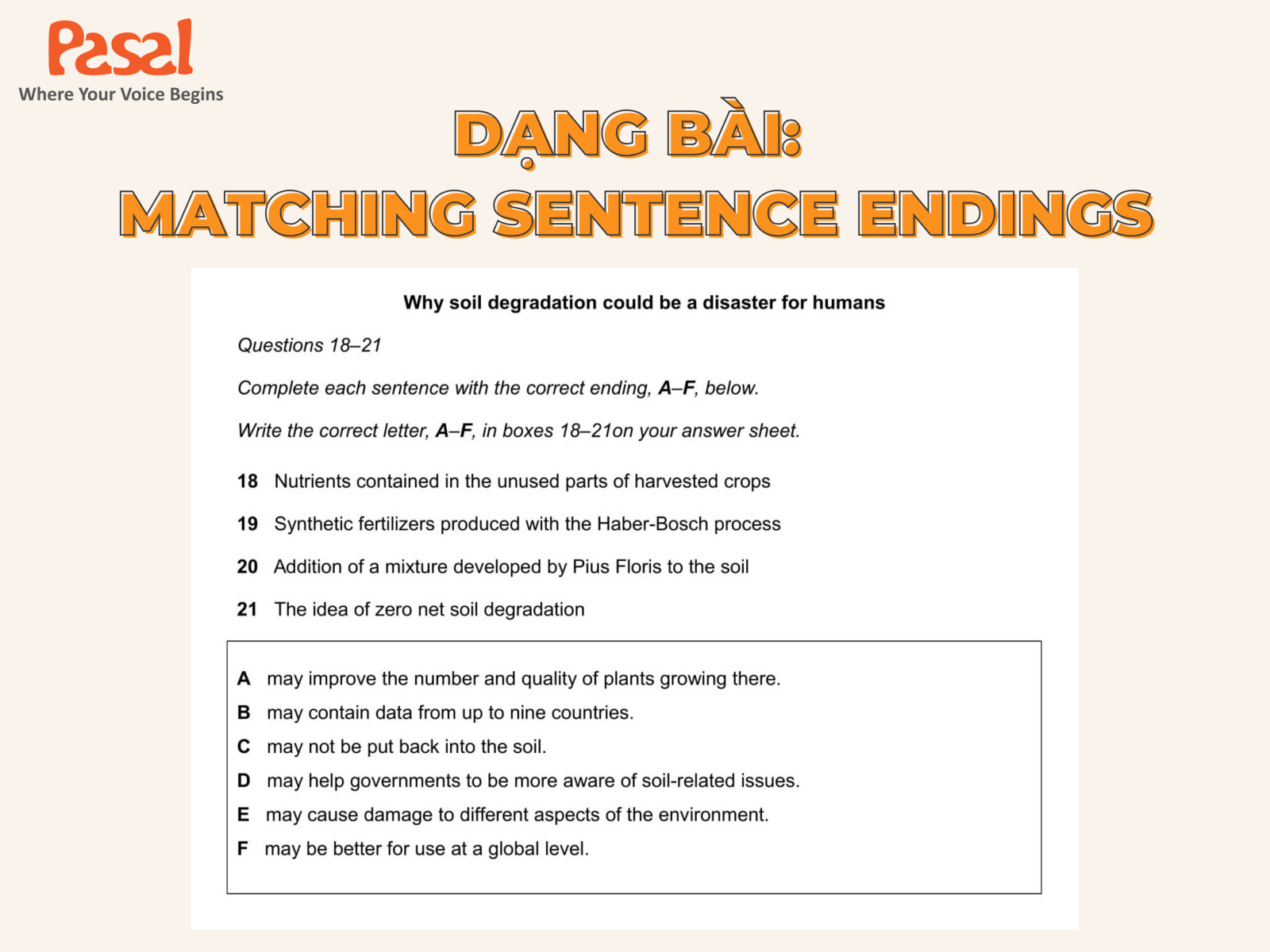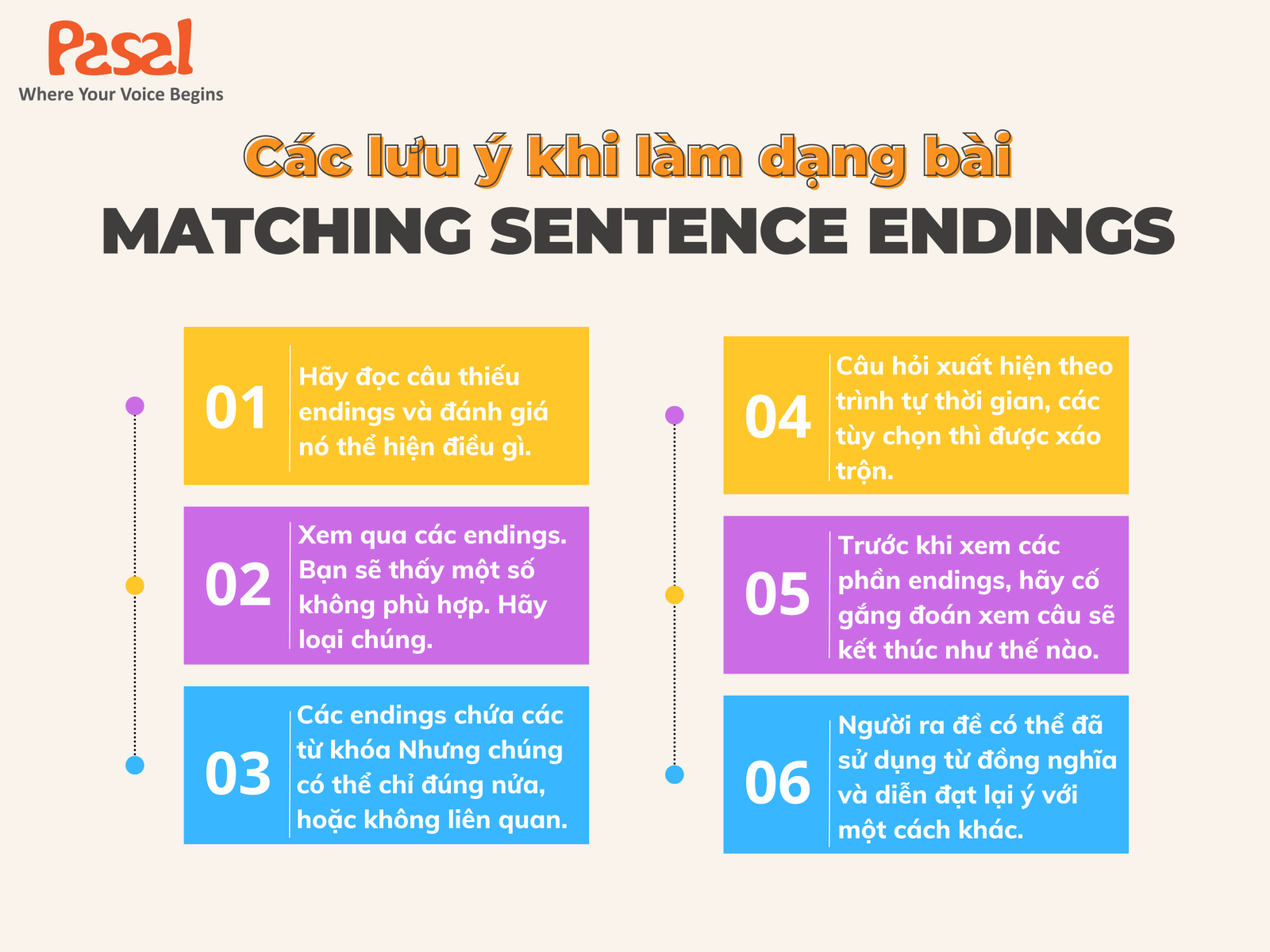Hướng dẫn cách làm bài Matching Sentence Endings IELTS Reading
Hướng dẫn cách làm bài Matching Sentence Endings IELTS Reading
Nội dung chính
Matching Sentence Endings IELTS Reading thường không xuất hiện nhiều trong đề thi IELTS. Tuy nhiên, để có thể đạt được kết quả cao thì việc nắm rõ cấu trúc đề bài cũng như các phương pháp làm bài hiệu quả là vô cùng quan trọng. Vì vậy hãy cùng theo chân Pasal khám phá chiến lược "ăn trọn điểm" dạng bài này nhé!
Khái quát về dạng bài Matching Sentence Endings IELTS Reading

Ví dụ về một bài "Matching Sentence Endings"
Dạng bài "Matching Sentence Endings" trong phần đọc của kỳ thi IELTS yêu cầu bạn phải ghép các câu thiếu mất phần ending và một list các ending để tạo thành một ending hoàn chỉnh và phù hợp với nội dung bài đọc.
Mục tiêu của bài là kiểm tra khả năng hiểu và nhận biết cấu trúc và ý nghĩa của đoạn văn, cũng như khả năng xác định mối quan hệ logic giữa các câu.
Các bước làm dạng Matching Sentence Endings IELTS Reading

Các bước làm dạng Matching Sentence Endings IELTS Reading
Hướng dẫn các bước làm Matching Sentence Endings IELTS Reading
Để làm đúng loại bài này, bạn cần đọc kỹ cả hai phần ghép nối và đoạn văn và tìm sự liên kết ngữ cảnh, từ khóa và ý nghĩa chung để đưa ra sự kết hợp chính xác.
Bước 1: Gạch chân từ khóa (keywords) trong câu hỏi
-
Đầu tiên, đọc câu thiếu ending một cách cẩn thận và tìm các từ khóa quan trọng. Các từ khóa này sẽ giúp bạn tìm kiếm thông tin tương ứng trong đoạn văn.
-
Những từ khóa này sẽ có thể được viết khác đi nhưng vẫn mang nghĩa tương đồng ở trong đoạn văn
Bước 2: Tìm từ khóa trong bài đọc theo thứ tự
Bây giờ, khi bạn đã biết từ khóa, đọc đoạn văn một lần nhanh để tìm các đoạn văn liên quan đến các từ khóa đã gạch chân. Điều này giúp bạn xác định nội dung và vị trí của thông tin trong đoạn văn.
Bước 3: So sánh thông tin với các câu endings
Tiếp theo, hãy so sánh các từ khóa đã gạch chân trong các câu thiếu endings và thông tin đã đọc trong bài với các câu ở phần Endings. Sau đó hãy chọn và ghép câu mà bạn cảm thấy phù hợp nhất. Nếu còn phân vân thì bạn hãy loại trừ để có được đáp án phù hợp nhất.
Bước 4: Check lại ngữ pháp và chính tả
Trước khi quyết định cuối cùng, hãy đảm bảo rằng câu bạn đã chọn là đúng ngữ pháp và chính tả. Điều này đặc biệt quan trọng trong kỳ thi IELTS Reading.
Các lưu ý khi làm dạng bài Matching Sentence Endings IELTS Reading
Lưu ý khi làm dạng bài Matching Sentence Endings IELTS Reading

Lưu ý khi làm dạng bài Matching Sentence Endings IELTS Reading
Dưới đây là 6 lưu ý quan trọng bạn cần ghi nhớ để làm dạng bài Matching Sentence Endings IELTS Reading đạt được kết quả tốt:
-
Đầu tiên, hãy đọc câu thiếu endings và đánh giá nó thể hiện điều gì, ví dụ như nguyên nhân, kết quả, mục đích hoặc sự đối lập.
-
Sau đó, xem qua các endings. Bạn sẽ thấy một số không phù hợp về ngữ pháp hoặc ngữ cảnh, nghĩa là chúng không mang ý nghĩa nào. Hãy loại chúng.
-
Hãy nhớ rằng có thể có các endings chứa các từ khóa hoặc thông tin từ phần này. Nhưng chúng có thể chỉ đúng một phần hoặc không liên quan.
-
Hãy nhớ rằng câu hỏi xuất hiện theo trình tự thời gian, nhưng các tùy chọn thì được xáo trộn.
-
Trước khi xem các phần endings, hãy cố gắng đoán xem câu sẽ kết thúc như thế nào.
-
Thay vì tìm những từ giống hệt nhau, hãy tìm xem người ra đề có thể đã sử dụng từ đồng nghĩa và diễn đạt lại ý với một cách khác.
Bài tập vận dụng

Hãy ôn luyện và làm nhiều bài tập để thành thạo Matching Sentence Endings. Cùng Pasal làm một bài tập ví dụ dưới đây nhé!
|
The Penny Black In 1840, the United Kingdom introduced the penny black, the first adhesive postage stamp issued anywhere in the world. For many years the postal service in the U.K. had been a very expensive service for ordinary people to use. The costs were prohibitive, a single letter sometimes costing a working person’s full day’s wage. The postal system also had many strange anomalies, such as certain categories of mail going free (and therefore being paid for by the charges on others), newspapers going for nothing, most mail being paid for by the addressee rather than by the sender, and so on. There were moves for postal reform for many years, until eventually these moves started gathering some force through the attention of many, amongst whom Rowland Hill is the best known, and Robert Wallace, MP for Greenock, was instrumental. The story is long and involved, but eventually, The Penny Postage Bill was passed by Parliament on 17 August 1839. Some basic elements of the plan were the lowering of postage rates for basic letters to one penny, the removal of certain idiosyncrasies, that prepayment would become normal, and the availability of printed envelopes, letter sheets, and labels to show prepayment. The “labels” were the penny black and twopence blue. A bookseller and printer from Dundee, James Chalmers, holds a strong claim to be the actual inventor of the adhesive postage stamp. He is said to have been interested in postal reform from about 1822, and to have printed samples of his idea for printed gummed labels in August 1834. It seems that, although Hill also presented the idea of adhesive stamps, he was probably keener on the use of standard prepaid letter folders, such as were issued in 1840 using a design by William Mulready. The new stamps went on sale on 1st May 1840 and were valid for postage from 6th May 1840 (although some were used during the 1st-5th May period). The Mulreadies were issued at the same time. Public reaction to these new items was quite the opposite to Rowland Hill’s expectations. The labels were well-received and admired; the Mulready design was lambasted and ridiculed. Initial supplies of the stamps were rushed through the printing and distribution process, but supplies soon caught up with requirements. The stamps were printed in sheets of 240, engraved on steel plates, on gummed paper with a single small crown watermark on each stamp. Eleven different printing plates were used, and it is possible in almost every case to work out which plate any individual stamp was printed from by a few characteristics. Things like the positioning of the corner letters within their squares, the presence of the “O flaw”, which rays of the stars in the upper corners are broken at what points, and so on, can point to a correct plate identification, but more specialised literature is required in order to do this. Some plates are scarcer than others, plate 11 being the scarcest. Every penny black stamp has letters in the lower two corners. These simply identify what sheet position the stamp occupied. When the printing plates were produced the lower squares were blank, and the letters were punched in by hand. The left square letter shows which horizontal row the stamp was in – the first row being A, the second B, and so on down to the twentieth row with T. The right square letter indicates the vertical column, again with A for the first column, B, C, and so on across to L for the last (twelfth) column. It should be noted therefore that each letter combination is just as common or as scarce as any other. There were 68,158,080 penny blacks issued (yes, 68 million!), and even with only a 2% survival rate, there are likely to be about 1.3 million still in existence. The survival rate may well be considerably higher than 2%, as it should be remembered that in 1840 the use of envelopes was unusual, most letters being written, folded, and sealed with sealing wax; this meant that whenever a letter was filed in a lawyer’s office, bank, etc., the whole thing would be kept – letter and outer cover including the adhesive stamp. From the collector's perspective, the physical condition of the stamp – any fault such as a thin, tear, crease, or stain will lower the value, and the number, size, and regularity of the margins make a big difference to value. The stamps were not perforated and had to be separated using scissors or a knife. As there was only about 1mm between one stamp and another, it was very easy to stray just a little and cut into the printed design of the stamp. A stamp with two full margins and perhaps a couple of other part margins is about average. Collectors will pay higher prices for examples with four good, wide, and even margins. |
Questions 1-6
Complete each sentence with the correct ending, A-I, from the box below.
Write the correct letter, A-I, as your answer to each question.
-
Breeding of dogs for appearance is harmful
-
Inbreeding is a major concern
-
The dogs in a puppy mill
-
The investigation by Dogs Trust reveals
-
The pet owners prefer high-priced animals
-
The hot and hum
A. because it makes looks more important for buyers.
B. unsuitable for breeds native to colder regions.
C. because it interferes with their genetic code.
D. are generally maltreated.
E. the illegal transportation of puppies to the UK.
F. because it leads to genetic disorders.
G. because purebred dogs are affected by it.
H. because they are considered a status symbol.
I. because they are healthy.
Đáp án:
1. C
2. B
3. F
4. A
5. D
Lời kết:
Trên đây là cách làm Matching Sentence Endings IELTS Reading, mong rằng nội dung này giúp ích được cho bạn. Hãy ôn luyện chăm chỉ để đạt được những kết quả tốt nhất bạn nhé. Pasal chúc bạn đạt được band điểm IELTS như bạn hằng mong muốn!
Trung tâm Anh ngữ PASAL tự hào là đối tác ĐỘC QUYỀN của chuyên gia Simon Corcoran tại Việt Nam về phương pháp giảng dạy IELTS hiện đại và hiệu quả. Không những vậy, PASAL cũng sẽ cam kết giúp bạn chinh phục được mục tiêu IELTS của mình với một lộ trình học tinh gọn - hiệu quả và tối ưu chi phí nhất!
Các bạn có thể tham gia test thử trình độ tiếng Anh và học thử miễn phí cùng PASAL tại đây:







![[PDF] Review chi tiết sách English Collocations In Use (download miễn phí)](http://pasal.edu.vn/images/news/2024/04/small/english-collocations-in-use-thumbnail_1714014751.png)
![[PDF + Audio] Review chi tiết sách Get Ready for IELTS cho người mới bắt đầu](http://pasal.edu.vn/images/news/2024/04/small/get-ready-for-ielts-thumbnail_1714013332.png)






Bình luận bài viết